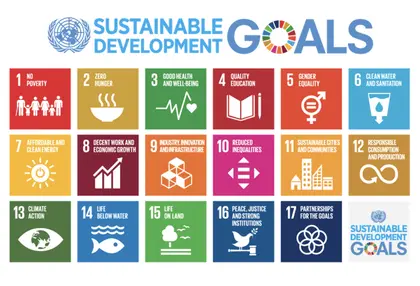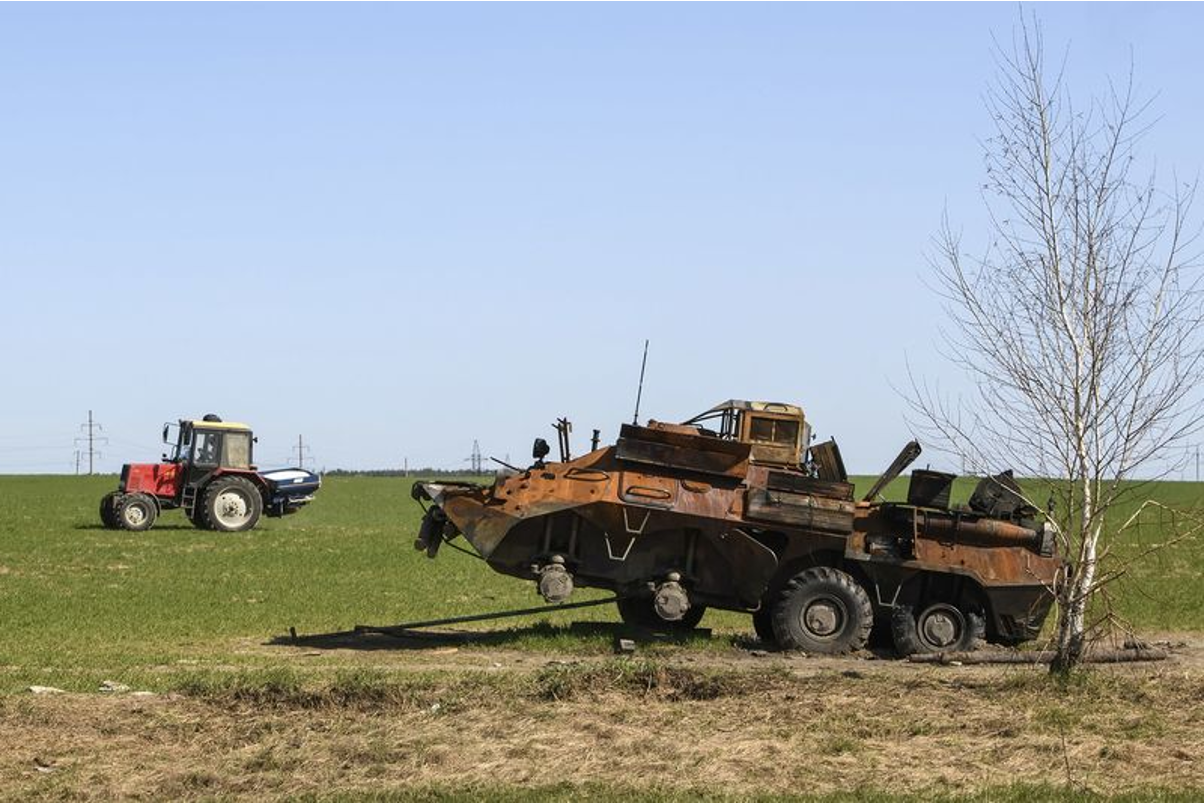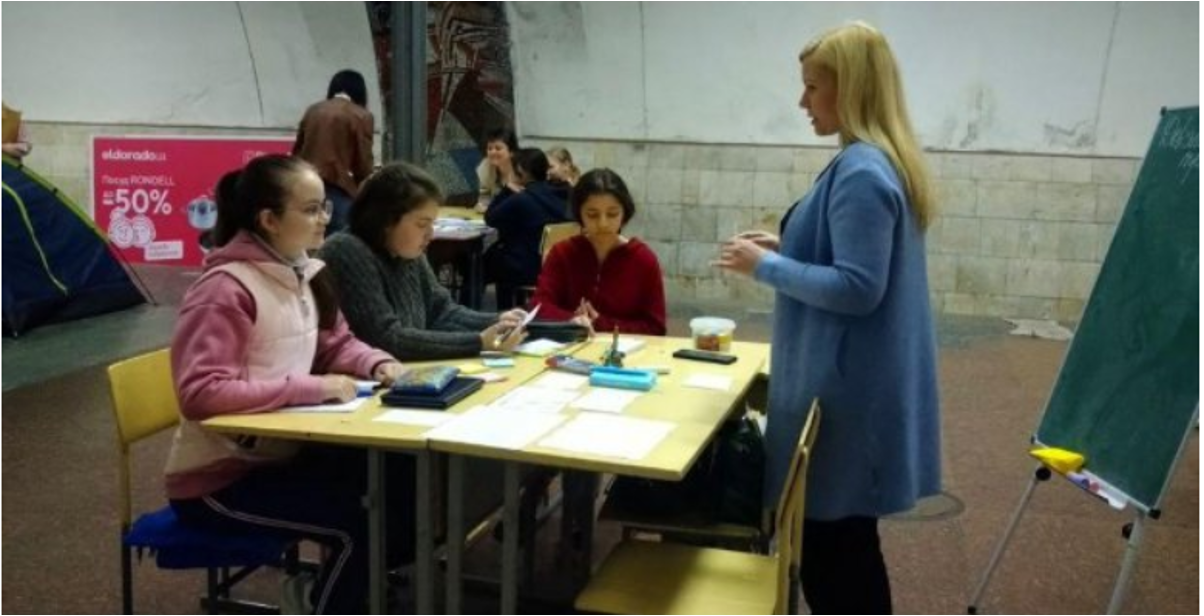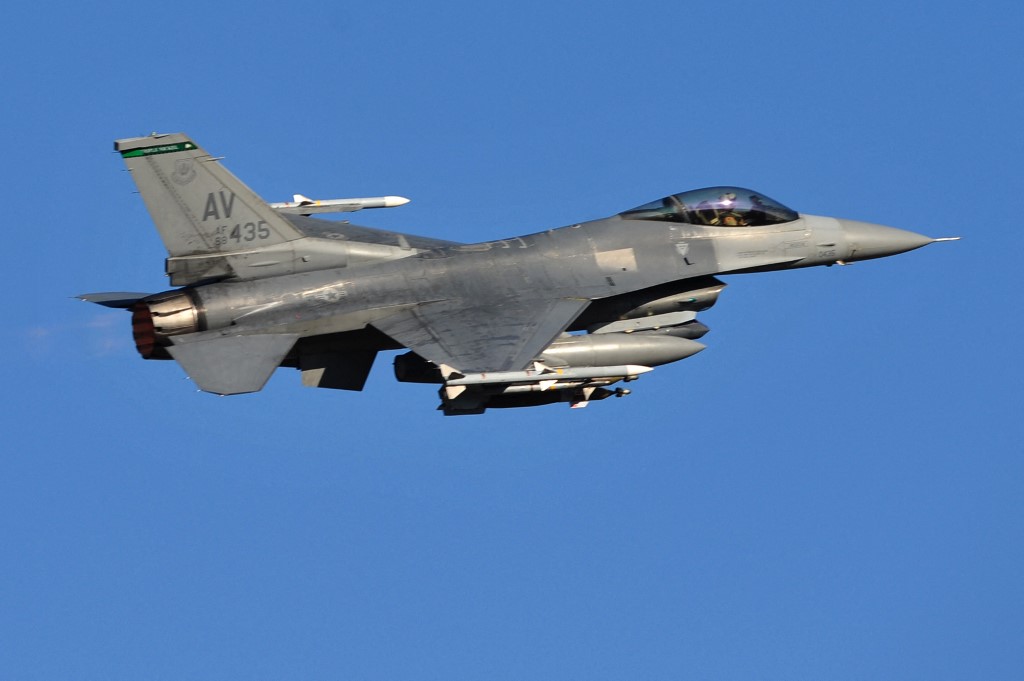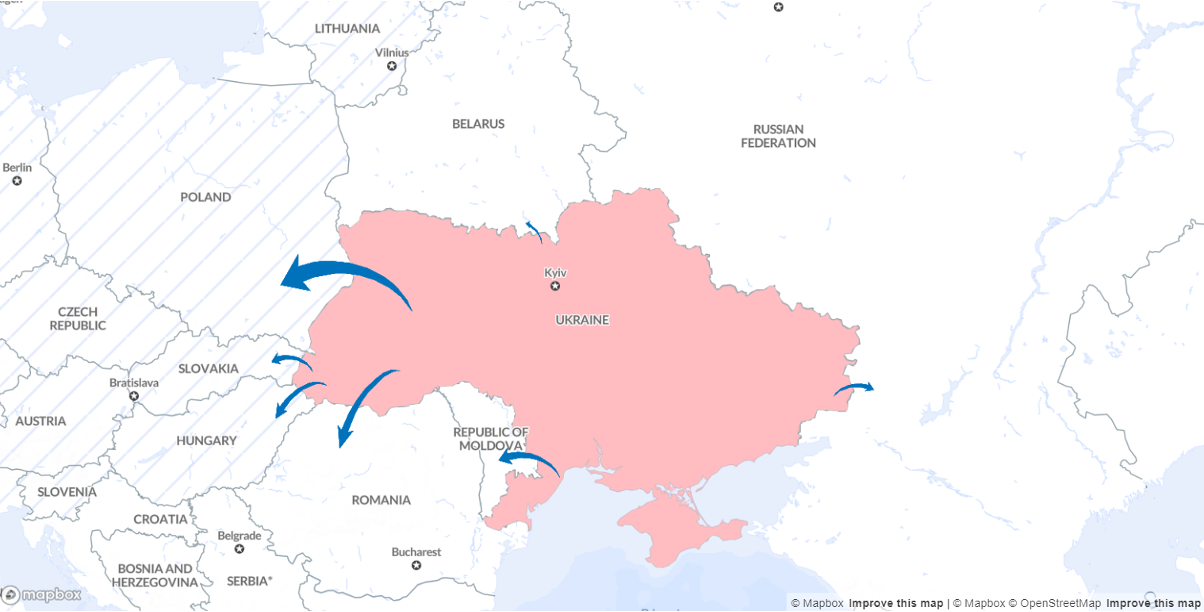Since September 2015, states, companies and public organizations have been working to preserve the future for the next generations based on the 17 sustainable development goals (SDG) developed by the UN General Assembly.
But one factor could nullify all international community’s achievements — the war. The terrible reality is that the war affects the current moment and threatens the achievements of sustainable development programs for the future. Goal by goal, let’s figure out how Russian military aggression in Ukraine affects sustainable development goals worldwide.
JOIN US ON TELEGRAM
Follow our coverage of the war on the @Kyivpost_official.
Goals #1 “No Poverty” and #8 “Decent Work and Economic Growth”
According to the Office of the United Nations High Commissioner for Refugees, more than 6.9 million Ukrainians have left the country, losing their homes, jobs, and sources of income. The operation of almost 80% of Ukrainian companies and businesses was disrupted. Even after liberation of occupied territories, such regions are not safe to restore infrastructure and normal working conditions due to the landmines and other threats.
The World Bank says that the economy of Ukraine will be reduced by 45.1%. The same with the banking system. Currently, the situation is still stable due to the manual management of the financial system, injection from the National Bank of Ukraine, support from Western partners, and the availability of liquidity in banks. But the economic shock is ahead. After the end of active hostilities, the National Bank of Ukraine will have to let go of manual control. Some banks will leave the market, and some will be nationalized. And, of course, this will all affect the economic well-being of Ukrainians.

EU Transfers €1.5 Bln Raised From Russian Assets for Ukraine
The area sown with spring grain crops for the harvest of 2022 due to the war may be reduced by 30-40%. Following preliminary estimates of APK Inform, the total harvest of grains and oilseeds may reach about 53 million tons—only half of last year’s record harvest. And this is only subject to the transition to positional combat operations and the localization of the conflict.
The destruction of Azovstal and other metallurgical plants will cause 30-40% losses in the metallurgical industry. Conforming to various estimates, Ukraine’s GDP in 2022 will be reduced by 35-50%; half of enterprise may be closed. The military situation brings considerable losses to international companies and impacts the GDP of European countries.
As a result of the Russian invasion, infrastructure facilities were destroyed: residential buildings, roads, bridges, hospitals, clinics and schools. In accordance with the Ministry of Economy of Ukraine and the Kyiv School of Economics (KSE) estimates, from February 24 to May 2, material damage is more than $92 billion. And the indirect loss is about $600 billion.
For comparison, the UN’s latest assessment of damage to Syria due to the three years of armed conflict reaches $442 billion indirect loss, including direct losses from the physical destruction of infrastructure and industrial facilities, estimated at $117.7 billion.
During three months of the war in Ukraine, at least 195 factories and enterprises, 231 medical institutions, 543 kindergartens, 295 bridges and bridge crossings, 151 storage facilities, 97 religious and 144 cultural sites were damaged, destroyed or seized. Due to hostilities, at least 23.8 thousand kilometres of roads, a length of 5 road trips from New York to San Francisco, and 33.7 million square meters of housing stock, a square of 680 Stanford Bridge stadiums, were damaged, destroyed or seized. Direct losses of enterprises’ assets and warehouses from the war already amount to about $10 billion.
Goals #2 “Zero Hunger”, #3 “Good Health and Well-beingand”, #6 “Clean Water and Sanitation”
The worst thing in any war is the loss of lives. According to preliminary data from the UN High Commissioner for Human Rights Office, civilian casualties from February 24, 2022, to June 3, 2022, reached 9,197: 4,183 killed and 5,014 injured.
The most common causes of injury and death are:
- explosive devices with a wide area of effect;
- shelling from heavy artillery and multiple launch rocket systems;
- rocket and airstrikes;
- firearms homicides by Russian soldiers.
The accurate figures are likely to be worse because it is impossible to collect data in cities with active hostilities — this applies to the cities of Mariupol, Izyum, Popasna, and the occupied towns and villages of the Kherson region.
In the occupied cities, such as Mariupol, the Russian army did not allow humanitarian corridors, so people died from hunger, cold, and lack of water. Citizens of Mariupol used water from radiators, toilet tanks, and melted snow from the street for drinking; they starved in shelters waiting for shelling. Starvation and life in unsanitary conditions led to death and numerous infectious diseases. Survived citizens have got significant trauma that affects psychological health, especially children’s.
The problem of hunger and health concerns not only the people of Ukraine. The food security of more than 50 countries in North Africa, the Middle East and Asia that depend on Ukraine, which consume more than 30% of wheat, is under threat. Such countries are Egypt, Bangladesh, Turkey, Iran, Lebanon, Tunisia, Pakistan, etc.
For example, Eritrea’s wheat imports are 50% dependent on Ukraine. The same is true in Somalia. Seychelles imports 100% grain from Ukraine.
Lately, wheat has been Egypt’s essential staple, accounting for between 35% and 39% of the per-person energy intake. And wheat imports are around 62% and come from Ukraine and Russia.
This means that the military actions in Ukraine directly impact the food security of countries with low living standards, where wheat products form a large part of the daily diet.
The stocks of the sunflower oil market are also under threat because Ukraine supplies about 50% of the world’s reserves.
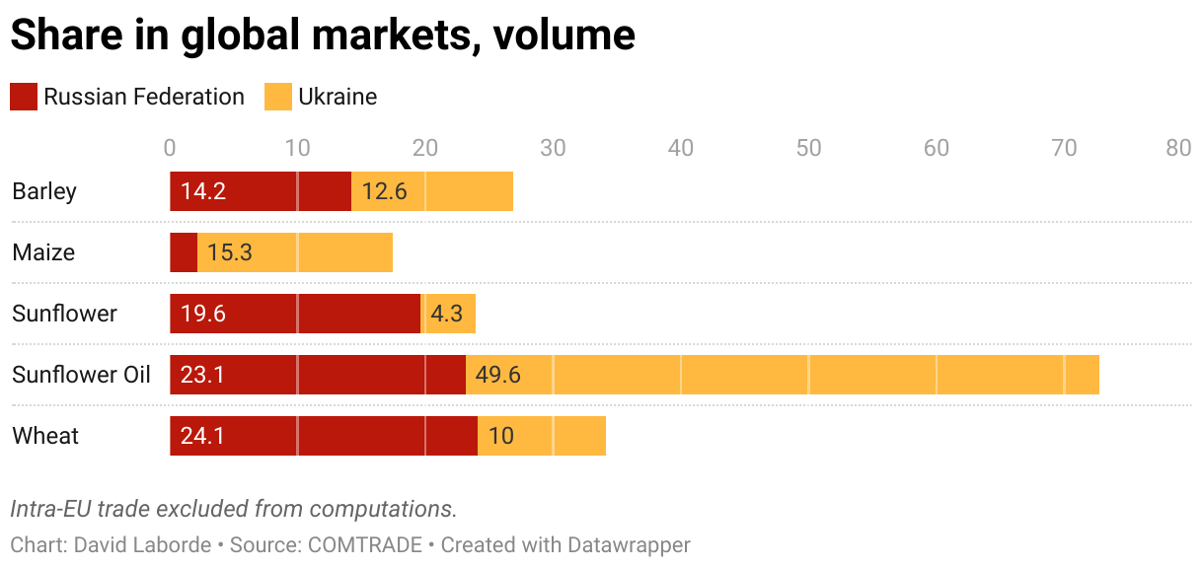
Export is complicated because mines plant some fields, and it is impossible to cultivate them, and some territories are under occupation. Russian troops have blocked all ports, and there is no way to export agricultural products from storage to other countries. Moreover, a lot of agricultural equipment was destroyed due to shelling and bombing.
The occupiers continue to export food stolen in Ukraine to the territory of Russia and the occupied Crimea. In Rody, Zaporizhzhya region, grain, and sunflower seeds were transported to the occupied Crimea. In the village of Volokhov Yar, Kharkiv region, the invaders took the grain out of the hangars. 27 thousand tons of grain were illegally exported and transferred to Syria.
Goal #4 “Quality Education”
As stated by the Ministry of Education and Science of Ukraine, more than 1140 educational institutions were destroyed or damaged. Today, schools and universities partially work remotely, but not all schoolchildren and students have the opportunity to study: someone is in an unsafe place, and someone doesn’t have the technical ability to join classes.
For example, in Kharkiv, teachers organise lessons at metro stations where they take cover from shelling. Despite the perseverance and professionalism of Ukrainian teachers, a decline in the quality of education in such conditions is inevitable.
Goals #13 “Climate Action”, #14 “Life Below Water”, and #15 “Life on Land”
War causes direct damage to the environment: the movement and use of military equipment destroy entire habitats and ecosystems that can no longer be restored. Armed clashes and activities of military units on the territory of Ukraine kill flora and fauna of fields, meadows, forests, rivers, and lakes. Gas emissions and new oil slicks were recorded in the Azov and Black Seas.
The World Health Organization considers air quality dangerous, with levels of pollution equal to that of a highly industrialised country and an average annual concentration of PM2.5 twice the legal limits. For example, on March 19, 2022, the concentration of pollutants in the air of Kyiv was 33 times higher than the norm recommended by WHO. Kyiv was in first place in the world in terms of air pollution, beating Lahore and Dhaka.
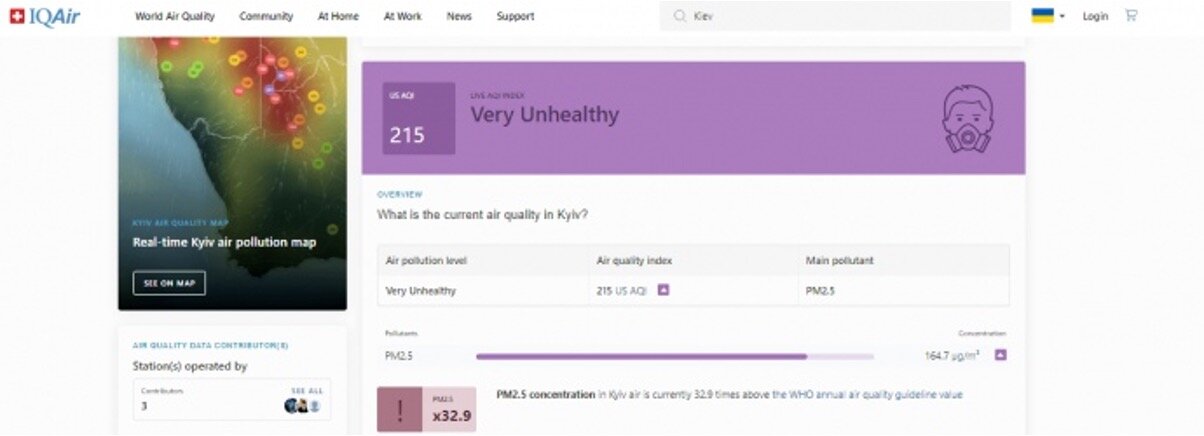
State airspace boundaries matter to aircraft, but not to the air. Depending on the direction, the wind carries harmful particles and emissions to nearby countries.
One of the leading environmental impacts is increased air and environmental pollution. There is a large amount of fine dust in the atmosphere, and particles accumulating on the ground often contain many acidic or toxic contaminants. These substances and metals pass into the Earth’s aquifer and pollute the water in the medium and prospective term.
Metals and rare earth elements in weapons require extracting economic and social costs. Their life cycle as a product does not end: they remain in the environment without proper disposing.
At the end of February 2022, Russian troops occupied the Chernobyl nuclear power plant. According to Reuters, referring to interviews with station employees, Russian tanks violated the topsoil, which led to the rise of radioactive dust.
Among the primary damage caused by the war at the ecological level is the significant consumption of energy resources and fossil sources. Oil and gas are consumed in large quantities for military exercises and during conflicts.
As for the pollution by military equipment, a light tank consumes 300 litres of fuel per 100 kilometres and emits more than 600 kilograms of CO2 into the atmosphere. The fighter jet consumes more than 400 litres of fuel for every 100 kilometres and emits about 28,000 kilograms of CO2 into the atmosphere for each flight mission. For an analogy, the average new car emits 8 to 15 kilograms of CO2 per 100 kilometres.
The war in Ukraine is a disaster for global sustainable development
Everything is interconnected, and war in one country affects others. One of the proofs is the problem of Ukrainian refugees.
Since the onset of the Russian invasion, one-third of Ukrainians have been forced from their homes. This is the largest human displacement crisis in the world today.
Following The Operational Data Portal (ODP), over 7.1 million people remain displaced by the war within Ukraine and 15.7 million people are estimated to urgently require humanitarian assistance and protection. As of today, UNHCR estimates there are over 4.7 million refugees present across Europe. More than 6.9 million refugee movements have been recorded out of Ukraine. At the same time, authorities have reported more than 2 million movements back into the country.
This is the biggest humanitarian catastrophe in Europe in recent decades.
It is appropriate here to recall Goal #16 on promoting peaceful and inclusive societies for sustainable development, ensuring access to justice for all, and building effective, accountable and participatory institutions. The lack of results of this goal leads to wars that destroy all achievements of previous plans.
“The flap of a butterfly’s wing on one continent can set off an earthquake on another.”
In the global world, everything is so interconnected that the loss of one of the cells unbalances the entire system. Wars destroy what people have been building for hundreds of years. Wars destroy what was created for all countries’ future and sustainable development.
You can also highlight the text and press Ctrl + Enter



